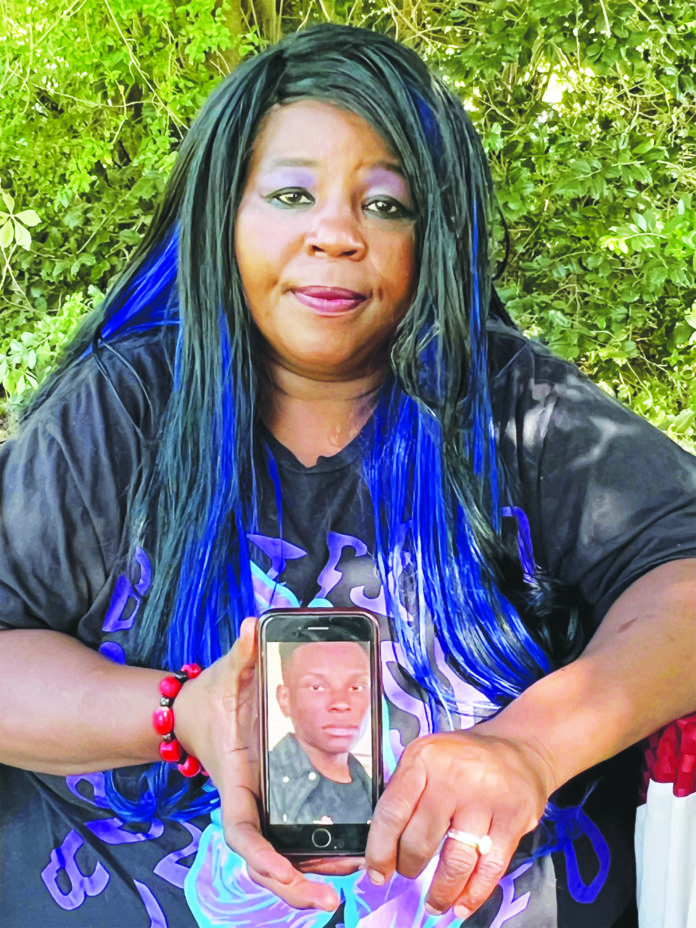
BY STEFANIE JACKSON, Eastern Shore Post —
Lonnie Smith was a young man who had an old soul — and a short life.
“I knew that I was going to lose him young,” said his mother, Angela Smith.
“I always knew.”
The promising artist died by suicide on Sept. 2, not far from his family home near Eastville, at an abandoned house where he often sought solace.
He was 23.
His death added to a troubling trend — suicide deaths have risen in the wake of the COVID-19 pandemic, according to state statistics.
Suicide rates on the Eastern Shore are higher than the state average.
Born on April 20, 2000, in Philadelphia, Lonnie Smith always felt like he never fit in.
He didn’t enjoy the same things as other young people in the Black community, his mother said. He never listened to hip-hop music and preferred rock ’n’ roll.
Smith liked to tell his mother he was born in the 1950s.
He was “wise beyond his years,” she said.
But the things that made the bright, loving child different also made him a target for bullying in school.
Even the kids who were friendly to him outside of school bullied him at school, his mother said.
In 2013, Smith was diagnosed with an anxiety disorder and began homeschool. He graduated in 2017.
Six years later, Smith logged into Facebook and wrote a goodbye note to his friends and family.
He told them to love one another, listen to one another, be good to animals, and take care of the planet.
“I love all of you so, so very much, my dearest friends,” he wrote, soon before he killed himself.
Exceeds state average
More than 1,000 people die by suicide in Virginia every year, statistics show.
In 2021, the last full year available, Accomack County had six suicide deaths, a rate of 18.6 per 100,000 people, according to a July 2023 report by the Office of the Chief Medical Examiner.
Northampton County had two suicide deaths, a rate of 17.1, according to the report.
The average rate of suicide deaths in Virginia is 14.1. By comparison, in the cities of Chesapeake, Suffolk, and Hampton, the suicide death rate is around 10 per 100,000.
The firearm suicide rate in Accomack County is 8.13 per 100,000, higher than Virginia’s average firearm suicide rate of 7.33 per 100,000 and the national average of 6.71 per 100,000, according to a national anti-violence group.
Suicide is preventable, and many suicide prevention resources are offered in Virginia and nationwide.
The National Suicide Prevention Lifeline, 1-800-273-TALK (8255), is free, confidential, and available 24-7 for people seeking help for themselves or loved ones in distress.
Virginia also offers the Suicide and Crisis Lifeline, which is available all day, every day, by calling or texting 988.
The Lock and Talk program offers free locks for firearms and medication boxes and promotes the safe storage of guns, medications, and other lethal means.
The Eastern Shore Community Services Board offers free trainings for suicide prevention and intervention.
Upcoming trainings can be viewed on the event calendar on the CSB website at www.escsb.org
Eager to help
Lonnie Smith was always forthcoming about his mental health, whether or not anyone wanted to listen.
He empathized with other people who suffered mental health conditions.
Despite his own struggles, Smith took the time to help those in distress — even if he was tired from a long day at work and they called him at 3 a.m.
He helped one friend through a mental health crisis and prevented another from taking her own life, his mother said.
“He was always sacrificing himself to save someone else,” she said.
Those personal sacrifices took a toll on Smith, who not only exhibited symptoms of anxiety and depression but experienced sleep paralysis.
He confided to his mother that demons were telling him to kill himself. He rarely slept.
In the last months of Smith’s life, he spoke frequently about how tired he was and how he longed to be at peace.
Angela Smith said she did everything she possibly could to help him, whether it was taking him to see a psychologist or talking to him until 2 a.m. after a particularly rough day.
One thing she couldn’t do was stop the constant stream of loss in her son’s life or his feelings of rejection.
After Smith moved back to the Eastern Shore with her young son, his father had little contact with him and started a new family in Philadelphia.
His friends would invite him out and cancel at the last minute or leave him behind.
The psychologist he was seeing retired. His health insurance provider stopped covering sessions with his most trusted therapist.
But there was one person who never seemed to let Lonnie Smith down.
Lars Stomne, of Delaware, first met Angela Smith and her son while visiting the Eastern Shore and stopping to eat at a restaurant where she worked as a cook.
Stomne befriended Lonnie Smith and took him on bicycling trips out of state, bought him an electric guitar, and introduced him to the art of photography.
Lonnie Smith thrived as an artist. His mother said not everyone liked his photography because the art was too “dark,” but he didn’t see it that way.
“I find beauty in the things you left behind,” Lonnie Smith wrote on his Facebook page.
His mother is now reaching out to the people he left behind so that his death is not in vain.

Her plea: “Be kinder — and listen.”


